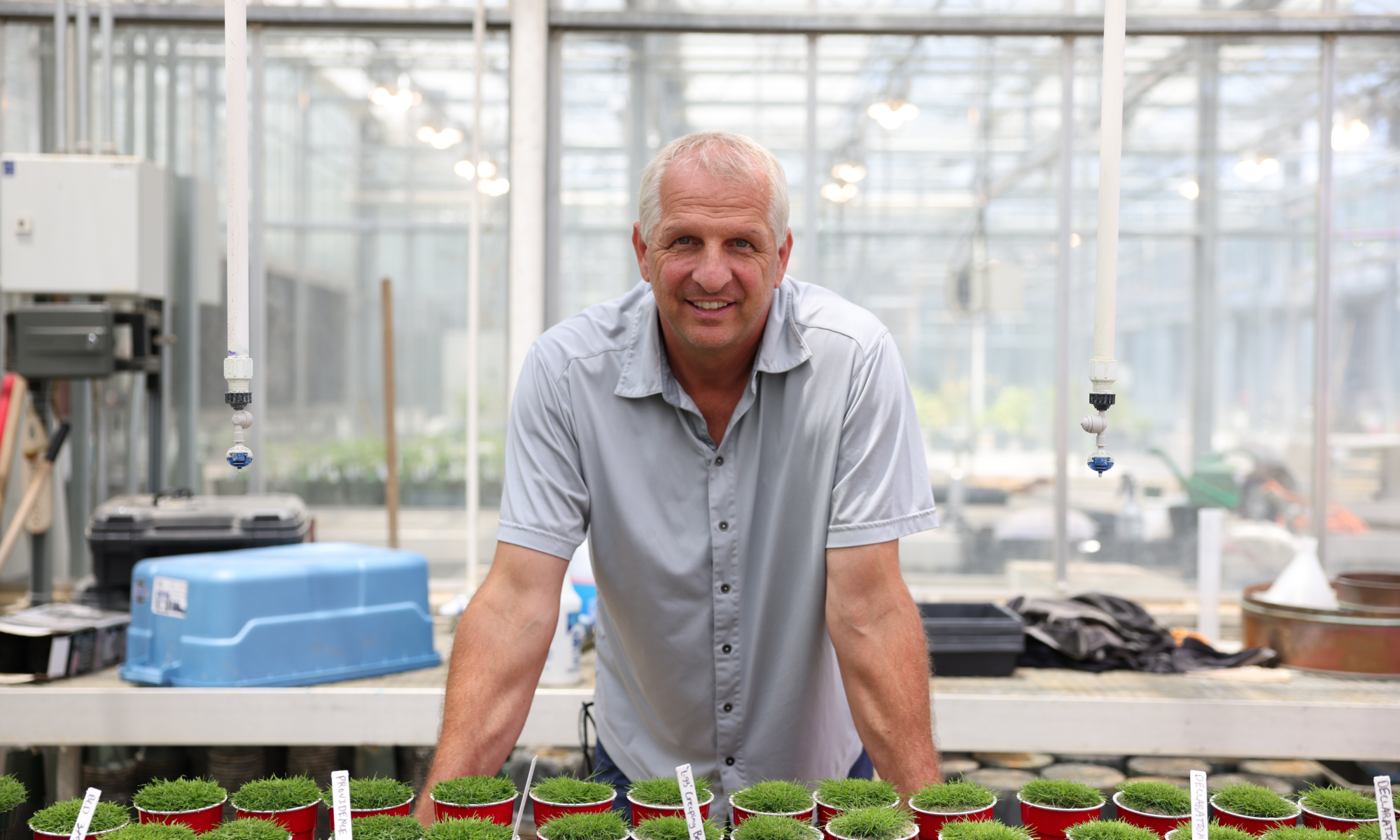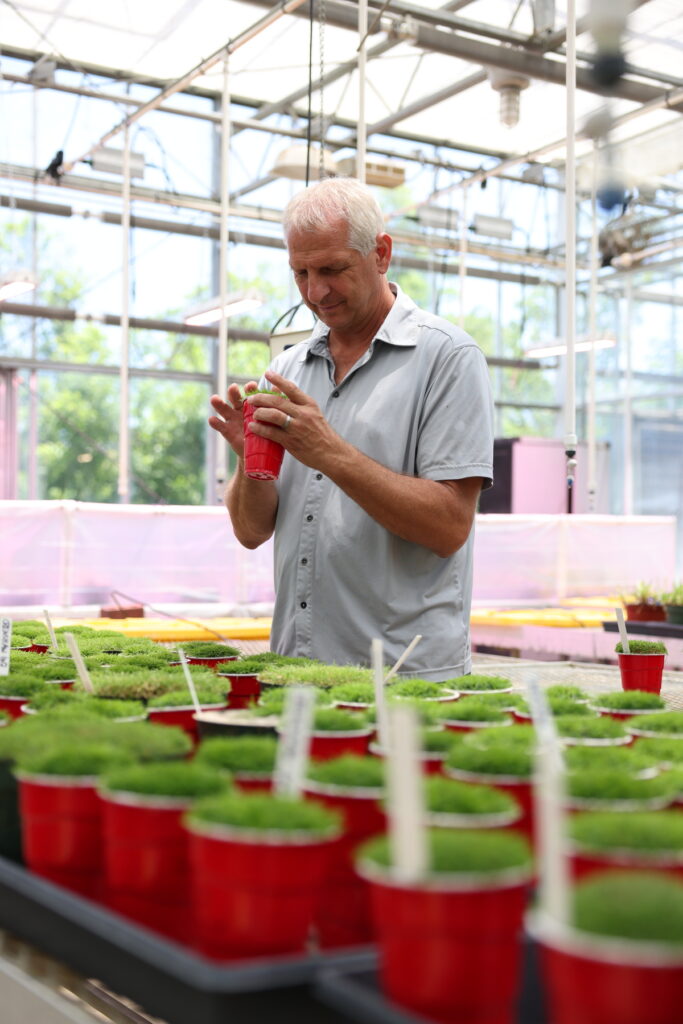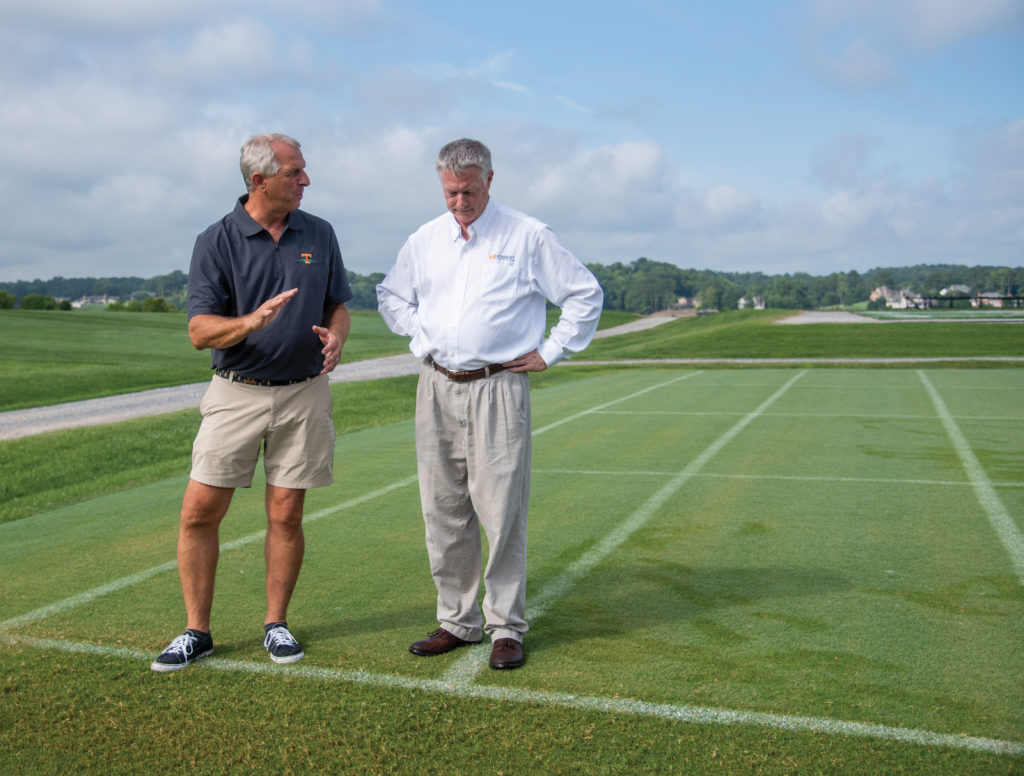
Distinguished professor of turfgrass science is researching ways to improve safety and wear tolerance of sports turf
What led you to the UT Institute of Agriculture?
What led me to UTIA was either serendipity, or the fact that I was the only candidate interviewing for the job!
In November 2001, I was at a professional meeting presenting my Ph.D. research, and Dr. Coleman Ward, turfgrass professor at Auburn University, said he thought I would be a great fit for the open faculty position at the University of Tennessee.
When I returned to Michigan State University, I found the job posting and prepared my application. As chance would have it, I was about to travel to East Tennessee to visit my now in-laws for Thanksgiving. Serendipitously, my future in-laws retired to Tellico Village in Loudon County in 1999, and I started visiting before even fathoming getting the job at UT. I contacted Dr. Bob Trigiano, who was leading the search, to ask about the position and he told me it was still open. I told him I would be passing through in one week and asked if I could stop by to talk about the position in person. He said absolutely, and he had me meet with several faculty on the Wednesday before Thanksgiving.
At the conclusion of my visit, I sat down with Bob Trigiano and asked him if I could apply for the job, and I handed him my application packet on the spot.
In mid-December 2001 I came back to UT for my official interview. After the holidays, I received a phone call from Dr. Neal Rhodes, Interim Department Head for Plant Sciences and Landscape Systems (now Plant Sciences) offering me the job. I knew that UT really wanted me because I was offered the job two days after UT handed the University of Michigan, MSU’s biggest rival, their worst ever loss in a bowl game. As a MSU alum, I took this as a positive sign and accepted the position on the spot!
What is your main research focus, and why it is important?
My main area of research is turfgrass science and management. I investigate species and cultivar evaluation for sports, golf, home lawn and sod production. For example, my home lawn turf research looks at improved cultivars that require less water and have improved environmental stress tolerances.
The biggest part of my research program is the sports turf research component. In addition to looking at improved species and cultivars with better wear tolerance, my research focuses on actual athlete to surface interactions for performance and safety as well as ball to surface interactions for soccer, baseball and even lawn tennis. The athlete to surface interaction research has expanded to include collaborating with UT biomechanics professors who bring the human expertise for player performance and safety.

What got you interested in turfgrass?
Growing up in Calgary, Alberta, Canada, my neighbor, Craig Ewanchuk, was like a big brother. Craig’s dad was also a golf course superintendent, and, like his dad, Craig worked in the golf industry building golf courses. Craig went to Michigan State University to study turfgrass and when he graduated, he moved to Spain to design and build golf courses all over Europe and Morocco for Robert Trent Jones, a very famous golf course architect.
Two days after I graduated from high school, my best friend and I set out to backpack through Europe for two months. When we were in southern Spain, we stayed with Craig for a few days, and that is where I first got exposed to the turfgrass industry. I thought that is was an amazing job – you get to work outside, design and build golf courses and travel the world.
When I returned home, I started at the University of Calgary. I was majoring in political science and geology, thinking I would be a lawyer in the oil and gas industry, but the idea of turfgrass was always on my mind. So, I decided to get a job on the grounds crew at Earl Grey Golf and Country Club. I immediately fell in love with the job and knew that a career in the turfgrass industry is what I wanted to do. So, I transferred to Michigan State University entering their two-year turfgrass management program, thinking I wanted to get into golf course design and construction.
In 1993, as I was finishing the program, I decided to finish my bachelor’s degree and entered into the undergraduate turfgrass management major at MSU. At the same time, MSU was awarded the project to research, build, and maintain the indoor turfgrass field to be used in the Pontiac Silverdome for the 1994 FIFA World Cup Soccer tournament. Growing up playing soccer, and being a lifelong soccer fan, I asked Dr. Trey Rogers, project lead and two-year turfgrass advisor, if I could work on the World Cup project. He hired me and sent me to meet his research technician, John Stier, to start working.
Working on the 1994 indoor turf research project for the World Cup was my first exposure to turfgrass research. I was hooked and knew that turfgrass research was what I wanted to do. About the same time, John Stier pulled me aside and told me I should consider going to graduate school. I began graduate school at MSU in 1995, and the rest is history for my interest in research and education.
What is your favorite part of your job?
Easily my favorite part of my job is all the people I get to work with and meet. I love mentoring and educating undergraduates and watching them go on to have successful careers in the turfgrass industry. Staying in touch with past students and helping them with their next job or career choice, sometimes even 10 years after they graduate, is very rewarding. I also love to work with and learn from my graduate students and research technicians. They are my lifeline for research and discovery.
I think we have the best turfgrass team anywhere. As turfgrass colleagues, we work extremely well together, and we share the same vision for what is best for UT Turfgrass. My fellow non turfgrass colleagues that I work with in the UTIA Department Plant Sciences and main campus are also outstanding. UT is a great place to work and the staff I work with are fantastic.
Which of your accomplishments brings you the most joy and personal satisfaction?
I think the accomplishment that brings me the most satisfaction is how I was a part of building the UT Turfgrass program to where it is today. When I started in May 2002, it was just myself and Tom Samples with 100% turfgrass faculty appointments. UT no longer had any research plots, and everything had to be built from scratch. I told Tom it will be interesting to see who gets on board and what we can build as a team.
Today, we have four turfgrass faculty with 100% turfgrass appointments, my old MSU boss John Stier, who is now Associate Dean of the Herbert College of Agriculture and Plant Sciences Turfgrass Professor, and Kyley Dickson, Research Leader 4 and Co-Director of the UT Center for Athletic Field Safety. Through hard work and great support from administration and faculty we have been able to grow the UT Turfgrass program to one that is recognized across the state, nation and world as one the top programs anywhere!
We understand that you and your students will be involved in the upcoming 2026 World Cup. Can you give us any updates on this exciting initiative?
UTIA is leading the research for the 2026 World Cup in North America, and we are collaborating with Michigan State University to conduct the research. This is allowing undergraduate and graduate students a tremendous opportunity to get involved with sports turf research. We have actively been doing research since 2021. This includes collecting baseline data from several high-profile stadiums around Canada, the U.S. and Mexico. Recently, a team of technicians, grad students, and undergrads setup research trials in Mexico City to identify the best species and varieties to use in stadiums that are located more than 9,000 ft above sea level.

What do you like to do outside of work and/or what is a fun fact about yourself that your colleagues and students wouldn’t know?
I love to spend time at home in my backyard with my wife Lisa and two boys, Ian (18) and Charlie (16). I love watching both of my boys play soccer and grow into the fine young men they are becoming.
I also love to travel for both work and pleasure. This summer I was able to take my family to Spain, and it was amazing!
